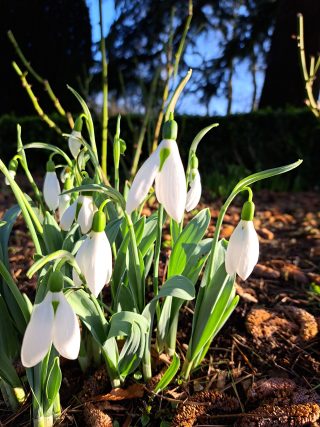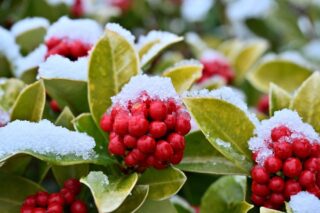Winter Walks: Biophilia and its benefits
In winter, the Irish landscape shines with a subtle beauty. Evergreen plants take centre stage. Deciduous plants bare their bones, providing elegant architecture. Delicate nodding snowdrops and hellebores emerge and many of our favourite scented plants are at their best – wintersweet (Chimonanthus praecox), sweetbox (Sarrococca sp) and Daphne among them.

Increasingly, researchers acknowledge the importance of daily contact with nature. Studies in multiple disciplines indicate the value of plants both wild and cultivated on human well-being. Exposure to nature can help deal with stress, depression and inattentiveness. Green spaces also give us a space to come together, facilitating connection and community.
There’s nothing quite like wrapping up warmly and taking a winter walk in any of our garden and parkland sites on a crisp day. Studies establish that we benefit physically, mentally and socially from being surrounded by nature. These benefits may be explained through the concept of “biophilia”, which holds that human beings have an innate affinity for living and growing things.
Biologist Edward O. Wilson defines biophilia as “the urge to affiliate with other forms of life”. Due to evolutionary processes, humans possess an innate tendency to seek connections with nature and other forms of life. We are a novelty seeking and social species, always on the lookout for new sensations to share with other people. Such drives would have been of competitive advantage to our ancestors in expanding their range. As a consequence, we delight in the sheer variety of colours and sounds, scents and taste, textures and shapes of nature – and crucially, in the continuous change in all of these through the seasons and across habitats.

For most of our evolutionary history, we were deeply connected to the landscape and the rhythm of the seasons. As we began to urbanise, we strove to maintain the connection – from potted plants to pets to landscape paintings, we seek connection to the natural world.
Following the industrial revolution, wealthy landowners in Europe began to create controlled natural experiences – hunting and pleasure grounds. Examples in Ireland include the Phoenix Park and Doneraile Estate.
In the early Victorian era, planting schemes featuring annual flowers in a formal pattern were de riguer. However, by the later 19th century, this gave way to the ‘wild garden’ approach of Irish garden designer William Robinson.
A most influential and respected gardener and horticultural writer, Robinson strove for ‘honest simplicity’. He established plants in places where they would thrive and spread without becoming invasive. Using perennial plants, he utilised a painterly approach to colour and texture.
Robinson was perhaps ahead of his time as the ‘wild garden’ approach not only taps into our innate biophilia but also allows space for biodiversity.
Sites such as Altamount Gardens, Annes Grove, and Heywood Gardens bear the hallmarks of his style today.
See our leaflet on Historic Gardens for inspiration and planning a day out.
Sources:
Wilson, E.O., 1984. Biophilia. Harvard University Press
Nelson, E.C. and McCracken, E.M., 1987. The Brightest Jewel: A history of the National Botanic Gardens, Glasnevin, Dublin. Boethius Press, Kilkenny
Robinson, W., 2011. The Wild Garden: Or, Our Groves and Shrubberies Made Beautiful. Cambridge University Press.
